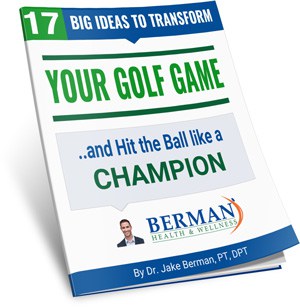
In America low back pain is the number one reason why male golfers stop golfing.
In addition, statistically speaking, 80% of all Americans will experience low back pain at some point in their life. It just so happens that golfing significantly increases your chances for experiencing low back pain, especially after the age of 50 years old.
Most golfers are familiar with Naples, FL and it’s reputation for having some (a lot) really great golf courses. It’s also not a secret that Naples is one of the most popular retirement destinations in the country. So it shouldn’t be any surprise that when you combine those two you get a high population of golfers over the age of 60 with back pain.
What Led US TO specialize in helping golfers
Now when I first opened Berman Physical Therapy in 2015, I had no interest at all in specializing in helping golfers with back pain. Mainly because at the time I was still terrible at golfing myself and thought that working with “athletes” would be more rewarding. You would think that after growing up in Naples I would be very aware of the relatively low population of “athletes” compared to retired golfers. It wasn’t till around 3 years into my business adventure that I realized over 75% of my patients over the years were golfers over the age of 60 with back pain! That is what led me to unintentionally specialize in helping golfers over the age of 60 with back pain relieve their symptoms and get back to playing golf without limitations.
Then over the next couple of years I started hearing more and more often of my patients coming back and telling me not only can they golf without back pain but they also are hitting the ball further off the tee than they had in years! This was my “light bulb” moment. This is when I had to question if those two results were correlated. Was it a coincidence that they were able to hit the ball farther off the tee and have less back pain or was it cause and effect?
So next I started doing my own case studies on golfers who did NOT have back pain. I would ask what their average distance off the tee was with their driver as our pre-test measurement. Then I would do the same intervention with them as I would do with my patients who had back pain.
What was the intervention?
Simply put, glute and core strengthening. But more specifically, “functional” glute and core strengthening. This is more than just doing some abdominal and glute exercises like planks and bridges. This is getting those muscles firing in a functional position and/or functional movement like the golf swing!
Again, keeping things very simple, just because you strengthen your core and glutes with “generic” exercises does not mean that you will be able to recruit and use that strength during your golf swing. I know this may not make sense but please trust me. You must train your brain on how to use that strength in very specific ways or your brain will compensate and do whatever it knows how to do to accomplish said task. This can get deep into neuromuscular science so I wont go any further- please email me at Drberman@bermanpt.com if you’d like more information on this particular subject.
The results blew my mind!
Taking people who did not have low back pain and working with them on functional core and glute strengthening directly led to these people increasing their distance off the tee 100% of the time! Yes, 100% of the time! This is when I knew that I had to pursue this and go all in.
So too very simply summarize what I found- core and glute weakness are BOTH causes of low back pain AND losing distance off your tee shots. I’ve known since the very beginning of my career that core and glute weakness leads to low back pain but I never attributed those deficits directly to losing distance off the tee shots. I, like so many others, thought losing distance is a normal part of aging and nothing could be done about it.
But then that wouldn’t make sense if you look at Phil Mickelson’s drive on the 16th hole at the 2021 PGA Championship… 366 yards!!! Are you freaking kidding me?!?! I don’t care if it was downwind, that is insane! This drive happened when he was 50 years old! So we cannot say that losing distance is a normal part of aging because if it was it would be across the board. Another example of somebody who is not on the PGA tour and simply a mere mortal is one of my clients Jim Means. At the time of this writing, He’s 67 years old and after working with us through The Berman Method he went from averaging 220 yards off his tee shots to hitting 285 yards! There will be much more on this particular example later but for now you can visit Bermanpt.com/golf to watch/listen to Jim’s story.
How does this Relate to Back Pain
Now that you have that background, I want to get back to how all this relates to back pain. Usually the first thing that comes to mind when thinking about golfing and back pain is... Tiger Woods! Again, if you're reading this you should be very aware of the battle Tiger Woods went through fighting his back pain symptoms over the 2nd half of his career. At the time of this writing and before knowing the exact details of his car accident rehab (2021), he had 5 back surgeries AND 5 knee surgeries. The important thing to note here is he had just as many back surgeries as he had knee surgeries yet his back pain was his biggest limiting factor.
Side note: If you are an “average Joe” like me, you should NOT be comparing yourself to the male golfers on the PGA Tour! They are gods and we are mere mortals. They are elite athletes who train/practice at least 8 hours every day and we are “weekend warriors” who usually play more than we practice. I’ll explain why this is important later.
Getting back to Tiger Woods and his battle with back pain. The general amature golfing population thinks that if Tiger Woods, arguably the best golfer of all time, can’t continue to play without back pain then nobody can. This also leads to the misconception that golfing is bad for your back.
golfing is NOT bad for your back!
I’m going to go on record now and say that golfing is NOT bad for your back if the golf swing is done properly! I’ll say that again in different words, when you use the right muscles and motions you should NOT have any harmful stresses on your lower back.
Tiger Woods has one of the most ballistic golf swings of all time! He was the originator of “swinging out of your shoes”. And because he was an elite athlete, he was able to get away with it for a long time until… he couldn’t. I remember hearing him say multiple times between his 4th and 5th back surgery “I’m not firing the glutes” or “I can’t get the glutes to fire” which is a major clue to what we are going to talk about shortly.
Let’s paint a picture of an average male golfer (Jacob) who has hit the ball on average:
What’s the first thing Jacob tries to do to make up some of that lost distance in his 50’s? Swing harder!!! And similar to Tiger Woods, Jacob’s body (his back) will tolerate this increased stress for a certain amount of time until it doesn't, which usually happens in your 60’s.
Then Jacob’s back starts to stiffen up after he plays a round. Then it gets worse and turns into pain after he plays a round. Next Jacob can’t play as frequently as he’d like because he now has to take off at least 1 day between rounds which ultimately leads to taking off 2 days between rounds, then 3 days between rounds, to now just being able to play once a week. Ultimately ending in giving up because “my back is just too bad” and it’s no longer worth the resulting pain.
Over the years of working with golfers over the age of 60, this all has become very predictable. And the number 1 reason is that our bodies don’t move after the age of 50 like they did before the age of 50. I’m sure that 99% of people over the age of 50 will agree that their bodies don’t move/perform like they did even in their 40’s.
WHY IS THIS?
The reason why this is important is because you can get away with performing the golf swing without using the right mechanics (inefficient) before the age of 50 because your body moves differently- it’s much more forgiving. But after the age of 50, because your body doesn’t move as well anymore and you’ve lost flexibility in areas, certain body parts will start to “break down” when you do that same inefficient golf swing that you’ve done all your life. This is where you have to remember the chapter before this when I talked about the biomechanics of your spine and hips.
A very brief review: your upper back is supposed to twist left and right with a minor motion of bending forward and backward. Your lower back is supposed to bend forward and backward and NOT twist left and right. Your hips are ball and socket joints which can move pretty much in every direction.
One of the most common physical changes that occurs as somebody ages is they get shorter. The #1 reason why this happens is because of thoracic (upper back) flexion or when your chest bone drops down. This motion pulls your head forward and compresses your spine. Flexing the upper back (thoracic spine) blocks its ability to twist left and right.
What happens next?
The 1st thing that usually happens is due to a lack of thoracic spine twisting (shoulder turn), the golfer will bring the hands and arms back farther into the backswing “wrapping the club around them” in an attempt to gain more “shoulder turn”. This almost always leads to flexing (bending) the left elbow and extending (straightening) the right knee (picture right handed golfers for this example) into the backswing.
Remember when I said earlier that poor posture blocks the ability of your thoracic spine to twist left and right?
Well a similar thing happens to the hip when you straighten your knee. During the golf swing, straightening your right knee through the backswing blocks your ability to fire your right glutes which inhibits your right hip from twisting/turning (your right hip is supposed to internally rotate during the backswing).
Because your right hip cannot rotate but you are still forcing the twisting motion into the backswing, you’ll ultimately twist and extend your low back to get that motion. Remember that the low back is NOT supposed to twist or turn left and right?
This my friends, is the #1 cause of back pain during the golf swing.
The low back muscles are very small in comparison to the hip muscles (glutes!!!). You can see this yourself if you ever go to a butcher shop. Simply look at a pork tenderloin, see how it is long and skinny? This is the equivalent of your low back muscles. It’s amazing how similar human and animal anatomy is… Next go look at the pork butt. It’s huge in comparison to the tenderloin! And yes size does matter when talking about strength!
Now think about it, which muscle would you want to be the primary mover when you are taking a long stick (driver) and trying to whack a golf ball as far as you can down a fairway? I sure hope you choose the butt!
Keeping things as simple as possible, Tiger Woods was swinging out of his shoes and only using his pork tenderloin! No wonder he had to have 5 back surgeries! This is essentially the same thing that happens with golfers over the age of 50. Because they are not specifically training their core and glutes during specific functional movements replicating the golf swing, their brain will rely on using the muscles it knows how to use, which is 99% of the time the pork tenderloin.
Stay tuned because next I’m going to explain how this relates to “over swinging” and how over swinging is the #1 cause of lost distance off the tee. Until then, remember this phrase “The slower you go (into the backswing), the farther it’ll (the ball) go.”

FREE REPORT
How to Transform Your Golf Game
...and hit the ball like a champion


